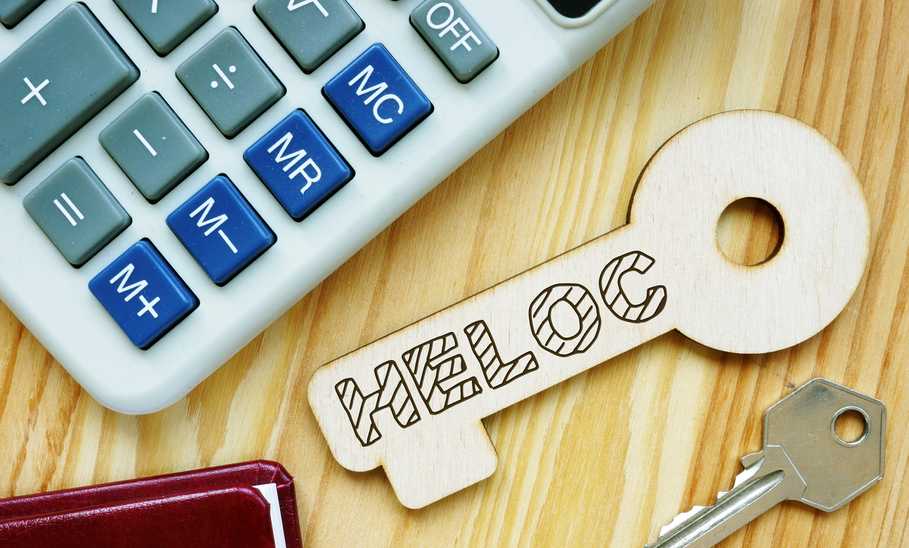Best HELOC Rates in February 2025

Our evaluations and opinions are not influenced by our advertising relationships, but we may earn a commission from our partners’ links. This content is created by TIME Stamped, under TIME’s direction and produced in accordance with TIME’s editorial guidelines and overseen by TIME’s editorial staff. Learn more about it.
A home equity line of credit (HELOC) can be a great way to borrow cash by accessing the equity you already have in your home. This cash can then be used for pretty much any purpose, whether you want to consolidate debt, cover a big purchase, tackle home renovation projects, or just have a financial safety net at the ready.
Choosing the right HELOC for you involves looking at the lender’s borrowing limits, repayment terms, and of course, the interest rates you’ll be offered. Here’s a look at some of the best HELOC rates for 2024 and how to find the lowest APR on your next home equity line of credit.
A nationwide lender, Bank of America offers a variety of financial products and services, including home equity lines of credit and loans. A HELOC from Bank of America has no application fees, no annual fees, and no closing costs on lines of credit up to $1 million.
Bank of America also offers introductory interest rates for the first six months, as well as the ability to lock in the rate on a HELOC draw at any point. This means that you can withdraw funds shortly after opening your line of credit then lock in that borrowed amount at a lower interest rate. There are also discounts for initial withdrawals, preferred bank members, and autopay.
With a Home Equity Flexline from Fifth Third Bank, you can borrow as much as $500,000 against your home’s current value with a term of up to 30 years. This HELOC product is offered on primary, secondary, and non-owner-occupied properties, such as rentals and investment homes.
The interest rate offered on a Fifth Third Home Equity Flexline may vary according to where the property is located and the value of the line of credit. For example, you could pay as low as Prime + 0.00% with no closing costs and interest-only payments for the length of the draw period. Rates on withdrawals can also be locked in for a $95 fee and later unlocked as needed.
As long as you have a credit score of at least 660, you may be eligible for a HELOC from U.S. Bank. This home equity line of credit gives you access to low rates as long as you’re borrowing $25,000 or more of your home’s current value.
Interest rates are variable but can be locked in at the time of withdrawal. You’re able to have as many as three locked rates at a given time, and U.S. Bank also offers interest-only repayment to those who qualify. There are no application fees or closing costs, either, and the $75 annual fee can be waived for checking account customers.
For homeowners in all states except Hawaii and Alaska, a HELOC from Signature Federal Credit Union can give you access to as much as 100% of your property’s equity. While most other lenders cap their loan-to-value ratio (LTV) limit at between 75% and 85%, SFCU offers up to 100% LTV with a total borrowing limit of $250,000.
You can take out a HELOC on a primary, secondary, or even rental (investment) home, though your maximum LTV may vary based on the property type. There are no origination fees or prepayment penalties when taking out a HELOC from SFCU, but there is a $250 processing fee.
The draw period includes the first 10 years, followed by a repayment term of 15 years. In order to apply, you’ll need to first become a member of SFCU.
The interest rate charged on most loans and credit products, such as home equity lines of credit, is based on the prime rate. This underlying index is used as a benchmark rate by many banks and financial institutions, and may change according to market conditions and the federal funds rate (set by the Federal Reserve).
Many banks will set their HELOC interest rate at a specific level above prime. For example, a bank could say that HELOC rates range from prime minus 0.50% to prime plus 5.00%. This way, you at least have a general idea of the spread of their rates, even if you cannot predict exactly what the prime rate will do moving forward.
As with all credit products, there’s no way to truly predict what HELOC interest rates will do in the future. And the rates that you’re offered can vary wildly based not only on the prime rate, but also your:
As HELOCs are secured by the equity in your home, rates may be lower on average than with unsecured forms of debt, such as credit cards or personal loans. It may also be easier to qualify for a HELOC, for this same reason.
As of this writing, a good HELOC rate is one that’s in the single digits. If you can stay below 10% or 11% variable APR, you’re likely locking in a competitive product.
If you’re shopping around for a new HELOC, it can be tricky to compare all of the options and lenders available to you. So, how can you best choose?
First, you’ll want to evaluate your HELOC needs, and what you really want to get out of your line of credit. This means asking yourself the following questions:
This will help you narrow your search. For example, if you’re looking to borrow 85% of your home’s value or take out a HELOC worth $400,000, you’ll want to eliminate lenders with a maximum LTV of 80% or borrowing limits that cap out at $250,000.
Next, consider how you plan to use the HELOC and when you’ll likely withdraw funds. If you know you’ll take out most of the money upfront, opting for a line of credit with an introductory interest rate or the ability to lock in a fixed rate on withdrawals might be beneficial. On the other hand, if you are mainly looking for a financial safety net, a HELOC with no annual fee might serve you better.
Be sure to consider all costs involved — from application and origination fees to withdrawal limits, interest rates, annual fees, and prepayment penalties — before choosing the HELOC that’s right for you.
HELOC rates ebb and flow along with the prime rate, which has increased from a low of 3.25% in March 2020 to the current 7.75%, as of early December 2024.
While even the experts aren’t sure where rates will go from here, most agree that this is an expensive time to borrow against your home’s equity. Some HELOC rates have hit all-time highs in recent months. However, the Fed cut interest rates by 0.50% in September and 0.25% in November, and at least one further rate cut is possible before the end of 2024, so the trajectory is changing.
With that said: HELOCs tend to have variable interest rates throughout the draw period. Due to the Fed’s recent rate cuts, variable rates are likely to follow suit. This means that you may be able to lock in a lower rate on future HELOC withdrawals. While this doesn’t help borrowers who need to tap into their home equity right now, it can be encouraging for those who plan to utilize it down the line.
Both HELOCs and home equity loans use your home’s owned value (equity) as collateral to secure a debt. Both are offered by financial institutions such as banks, mortgage lenders, and credit unions and both are limited by your home’s loan-to-value ratio (LTV) among other factors.
The difference is that a HELOC is a revolving line of credit that you can tap into as needed, at any time during the draw period. If you never need to borrow money, you never have anything to repay. A home equity loan, however, is disbursed in a single lump sum and then repaid with monthly payments over a set period of time. You can’t come back and request more money with a home equity loan, the way you can with a HELOC.
A HELOC is a revolving line of credit based on the equity in your home, or how much of your home’s value you own after deducting any liens, such as a mortgage loan. When you take out a HELOC, it’s a separate financial product and doesn’t change anything about your existing mortgage loan or interest rate.
A cash-out refinance, however, involves replacing your current mortgage loan with a new loan, while also withdrawing cash from your home’s equity. This new loan may have a different interest rate, repayment term, and monthly payment requirement, and will be used to pay off (and fully satisfy) any mortgage balance you still have.
HELOC lenders typically base their rates on the prime rate, which is a benchmark index. As this rate rises, so do interest rates overall, including those on home equity loans and lines of credit. As HELOCs often have variable interest rates that can change over time, borrowers need to be aware that the HELOC they open today could be more costly in the months and years to come.
The Federal Reserve has not indicated that it will lower rates yet in 2024, so homeowners can expect that their HELOC rates will remain stagnant for the time being.
*APR is subject to change. APR is updated as of Dec. 2, 2024.
The information presented here is created by TIME Stamped and overseen by TIME editorial staff. To learn more, see our About Us page.



